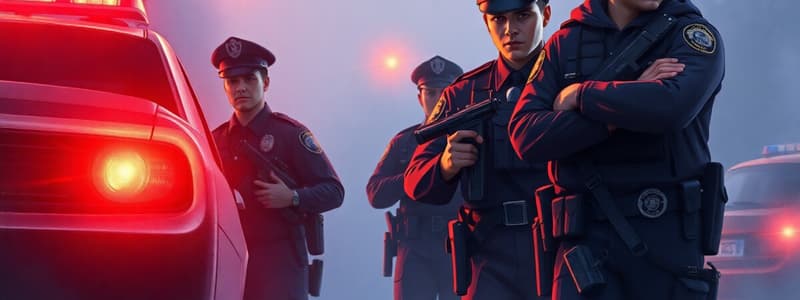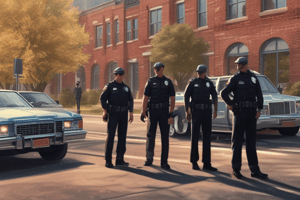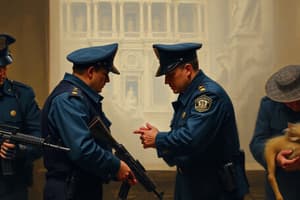Podcast
Questions and Answers
According to OPD policy, which team has sole responsibility for criminal investigations and case management of incidents resulting in serious injury or death involving use of force by an OPD officer?
According to OPD policy, which team has sole responsibility for criminal investigations and case management of incidents resulting in serious injury or death involving use of force by an OPD officer?
- The Criminal Investigations Bureau (CIB)
- The Officer-Involved Investigations Team (OIIT) (correct)
- The Special Victims Unit
- The Internal Affairs Unit
What is the primary responsibility of involved officers immediately after a use of force incident resulting in serious bodily injury or death?
What is the primary responsibility of involved officers immediately after a use of force incident resulting in serious bodily injury or death?
- To control threats to safety, request medical assistance, administer first aid, and protect the scene. (correct)
- To begin interviewing witnesses and collecting evidence.
- To immediately leave the scene to avoid compromising the investigation.
- To consult with legal counsel before taking any further action.
Which of the following is NOT a stated responsibility of a witness officer immediately after an officer-involved incident resulting in serious bodily injury or death?
Which of the following is NOT a stated responsibility of a witness officer immediately after an officer-involved incident resulting in serious bodily injury or death?
- Administering first aid to anyone in need.
- Providing a detailed written statement to the media. (correct)
- Identifying witnesses and requesting their cooperation.
- Requesting a supervisor and additional units.
What is the role of Responding Officers after a use of force incident?
What is the role of Responding Officers after a use of force incident?
The OIIT is commanded by a Captain and reports to which entity?
The OIIT is commanded by a Captain and reports to which entity?
What does 'OIIT' stand for in the context of Omaha Police Department policy?
What does 'OIIT' stand for in the context of Omaha Police Department policy?
In the event that both an Involved Officer and a Witness Officer are present at a scene where deadly force was used, who has the primary responsibility of coordinating the arrival of Responding Officers and directing a perimeter for scene preservation?
In the event that both an Involved Officer and a Witness Officer are present at a scene where deadly force was used, who has the primary responsibility of coordinating the arrival of Responding Officers and directing a perimeter for scene preservation?
An off-duty OPD officer witnesses a serious assault and uses their firearm to prevent further harm to the victim, resulting in the assailant's death. According to OPD policy, which of the following actions MUST occur?
An off-duty OPD officer witnesses a serious assault and uses their firearm to prevent further harm to the victim, resulting in the assailant's death. According to OPD policy, which of the following actions MUST occur?
Who must an OIIT Lieutenant consult with to determine which officers need to submit detailed Supplementary Reports?
Who must an OIIT Lieutenant consult with to determine which officers need to submit detailed Supplementary Reports?
What is the responsibility of the UPB officer assigned to stay with the subject at the hospital?
What is the responsibility of the UPB officer assigned to stay with the subject at the hospital?
Who qualifies as an immediate family member for a private viewing of a deceased person at the hospital?
Who qualifies as an immediate family member for a private viewing of a deceased person at the hospital?
What action must the OIIT Hospital Sergeant take upon a subject being pronounced clinically dead?
What action must the OIIT Hospital Sergeant take upon a subject being pronounced clinically dead?
What is the primary responsibility of the officer assigned as the floor monitor at CPHQ during an incident investigation?
What is the primary responsibility of the officer assigned as the floor monitor at CPHQ during an incident investigation?
Besides detectives involved in the investigation, which other OPD employees are allowed access to the CPHQ fourth floor during the initial stages of an incident investigation?
Besides detectives involved in the investigation, which other OPD employees are allowed access to the CPHQ fourth floor during the initial stages of an incident investigation?
Which of the following is NOT a responsibility of the OIIT Interview Sergeant?
Which of the following is NOT a responsibility of the OIIT Interview Sergeant?
What determines whether Witness Officers need to complete a formal interview, a detailed written report, or provide a verbal statement?
What determines whether Witness Officers need to complete a formal interview, a detailed written report, or provide a verbal statement?
An additional OIIT On Scene supervisor can be leveraged for secondary scenes, what authority do they have?
An additional OIIT On Scene supervisor can be leveraged for secondary scenes, what authority do they have?
How does the policy ensure proper chain of custody for evidence gathered from the hospital or UPB officer?
How does the policy ensure proper chain of custody for evidence gathered from the hospital or UPB officer?
What should officers transporting cooperating witnesses instruct them to do?
What should officers transporting cooperating witnesses instruct them to do?
What action should officers take if a witness who claims to have observed the incident refuses to cooperate at the scene?
What action should officers take if a witness who claims to have observed the incident refuses to cooperate at the scene?
According to the provided information, what is a potential consequence of transporting witnesses from a crime scene to another location without their consent or probable cause?
According to the provided information, what is a potential consequence of transporting witnesses from a crime scene to another location without their consent or probable cause?
Who is responsible for completing reports from the scene of an incident involving an officer?
Who is responsible for completing reports from the scene of an incident involving an officer?
Who should the Internal Affairs Unit notify if they have not already been notified of an incident?
Who should the Internal Affairs Unit notify if they have not already been notified of an incident?
Who assumes responsibility for the OIIT members and takes command of the investigation?
Who assumes responsibility for the OIIT members and takes command of the investigation?
According to the content, who is responsible for coordinating and assigning personnel to make next of kin notifications for suspects and all decedents?
According to the content, who is responsible for coordinating and assigning personnel to make next of kin notifications for suspects and all decedents?
What is the role of the UPB Incident Commander at the scene of an incident?
What is the role of the UPB Incident Commander at the scene of an incident?
Which entity should complete the inventory and round count of collected firearms?
Which entity should complete the inventory and round count of collected firearms?
Prior to any media releases that name any involved parties, what action must be taken regarding next of kin?
Prior to any media releases that name any involved parties, what action must be taken regarding next of kin?
Besides the OIIT Sergeants, which additional entities are required to be included in the investigation, per NRS §29-1401?
Besides the OIIT Sergeants, which additional entities are required to be included in the investigation, per NRS §29-1401?
Following an officer-involved incident, what determines the disposition (release, booking, cleaning) of the involved officer's equipment and clothing?
Following an officer-involved incident, what determines the disposition (release, booking, cleaning) of the involved officer's equipment and clothing?
In the context of handling firearms as evidence, what specific concern mandates that the firearm(s) should be directly collected by the FIU employees?
In the context of handling firearms as evidence, what specific concern mandates that the firearm(s) should be directly collected by the FIU employees?
What is the rationale behind ensuring the process of firearm inventory and round counts is recorded on audio/video in front of the Involved Officer, if possible?
What is the rationale behind ensuring the process of firearm inventory and round counts is recorded on audio/video in front of the Involved Officer, if possible?
Insanely difficult: Consider a hypothetical scenario where the OIIT On-Scene Sergeant is incapacitated, and the UPB Incident Commander is unavailable due to another emergency. Furthermore, the Forensic Investigations Unit is delayed due to a city-wide incident. According to protocol, what IMMEDIATE action should a patrol officer take to secure potential video evidence from cruisers on-scene, while adhering to the overarching principles of evidence preservation and chain of custody?
Insanely difficult: Consider a hypothetical scenario where the OIIT On-Scene Sergeant is incapacitated, and the UPB Incident Commander is unavailable due to another emergency. Furthermore, the Forensic Investigations Unit is delayed due to a city-wide incident. According to protocol, what IMMEDIATE action should a patrol officer take to secure potential video evidence from cruisers on-scene, while adhering to the overarching principles of evidence preservation and chain of custody?
What is the primary responsibility of responding Uniform Patrol Bureau (UPB) supervisors upon arriving at a scene?
What is the primary responsibility of responding Uniform Patrol Bureau (UPB) supervisors upon arriving at a scene?
According to the guidelines, what type of questions can a supervisor ask an Involved Officer immediately after arriving at the scene?
According to the guidelines, what type of questions can a supervisor ask an Involved Officer immediately after arriving at the scene?
Prior to the arrival of the OIIT, how should on-scene officers handle evidence if it is tactically safe to do so?
Prior to the arrival of the OIIT, how should on-scene officers handle evidence if it is tactically safe to do so?
What documentation should a UPB supervisor start or continue to ensure critical tasks are completed?
What documentation should a UPB supervisor start or continue to ensure critical tasks are completed?
What is the procedure for handling Involved Officer's weapons after a critical incident?
What is the procedure for handling Involved Officer's weapons after a critical incident?
Who should be notified in the event of a serious incident, in addition to the precinct and unit chain of command and CIB personnel?
Who should be notified in the event of a serious incident, in addition to the precinct and unit chain of command and CIB personnel?
What specific information should officers obtain from individuals during a neighborhood canvass after an incident?
What specific information should officers obtain from individuals during a neighborhood canvass after an incident?
When can BWC and MVR recording be stopped at an incident scene?
When can BWC and MVR recording be stopped at an incident scene?
What action should be taken regarding vehicles involved in an incident scene?
What action should be taken regarding vehicles involved in an incident scene?
What is the purpose of using privacy screens around bodies at a crime scene?
What is the purpose of using privacy screens around bodies at a crime scene?
If an Involved Officer declines to make a statement, what should the supervisor do?
If an Involved Officer declines to make a statement, what should the supervisor do?
According to policy, where are Involved Officers to be transported directly after a critical incident?
According to policy, where are Involved Officers to be transported directly after a critical incident?
What specific detail must be documented in a Supplementary Report after conducting a preliminary neighborhood canvass, if a residence is checked but no one is present?
What specific detail must be documented in a Supplementary Report after conducting a preliminary neighborhood canvass, if a residence is checked but no one is present?
In the context of evidence handling at a crime scene, what does 'marking the location' of evidence entail when it must be moved for safety reasons prior to OIIT arrival, and why is this practice critical?
In the context of evidence handling at a crime scene, what does 'marking the location' of evidence entail when it must be moved for safety reasons prior to OIIT arrival, and why is this practice critical?
Considering the complexities of managing Involved Officers after a critical incident, what specific legal and procedural rationale underpins the instruction that supervisors must not engage in questioning beyond immediate public safety concerns until the officer has had an opportunity to consult with legal representation and been advised of their Fifth and Sixth Amendment rights?
Considering the complexities of managing Involved Officers after a critical incident, what specific legal and procedural rationale underpins the instruction that supervisors must not engage in questioning beyond immediate public safety concerns until the officer has had an opportunity to consult with legal representation and been advised of their Fifth and Sixth Amendment rights?
Flashcards
OIIT Responsibility
OIIT Responsibility
Investigates deaths or serious injuries of subjects in OPD custody resulting from use of force by an OPD officer.
Involved Officer
Involved Officer
Any officer whose use of force (including weapon discharge) results in serious bodily injury or death.
Officer Involved Investigations Team (OIIT)
Officer Involved Investigations Team (OIIT)
Lieutenants, sergeants, and detectives who investigate officer-involved Use of Force incidents.
Witness Officer
Witness Officer
Signup and view all the flashcards
Involved Officer Immediate Actions
Involved Officer Immediate Actions
Signup and view all the flashcards
Witness Officer Immediate Actions
Witness Officer Immediate Actions
Signup and view all the flashcards
Responding Officer Immediate Actions
Responding Officer Immediate Actions
Signup and view all the flashcards
OIIT Command Structure
OIIT Command Structure
Signup and view all the flashcards
Relieve Witness Officers
Relieve Witness Officers
Signup and view all the flashcards
First-Aid Relief
First-Aid Relief
Signup and view all the flashcards
Identify Witnesses
Identify Witnesses
Signup and view all the flashcards
Maintain Perimeter
Maintain Perimeter
Signup and view all the flashcards
Incident Command
Incident Command
Signup and view all the flashcards
Coordinate Rescue Squads
Coordinate Rescue Squads
Signup and view all the flashcards
Preserve Evidence
Preserve Evidence
Signup and view all the flashcards
Secure Vehicles
Secure Vehicles
Signup and view all the flashcards
Secure Crime Scene
Secure Crime Scene
Signup and view all the flashcards
Employ Privacy Screens
Employ Privacy Screens
Signup and view all the flashcards
Collect BWCs
Collect BWCs
Signup and view all the flashcards
Involved Officer Questions
Involved Officer Questions
Signup and view all the flashcards
Do not Touch Weapons
Do not Touch Weapons
Signup and view all the flashcards
Remove Involved Officers
Remove Involved Officers
Signup and view all the flashcards
Crime Scene Log
Crime Scene Log
Signup and view all the flashcards
OIIT On Scene Detective Role
OIIT On Scene Detective Role
Signup and view all the flashcards
UPB Officer's Hospital Role
UPB Officer's Hospital Role
Signup and view all the flashcards
OIIT Detective's Hospital Evidence Role
OIIT Detective's Hospital Evidence Role
Signup and view all the flashcards
OIIT Interview Sergeant Role
OIIT Interview Sergeant Role
Signup and view all the flashcards
Interview Recording Requirement
Interview Recording Requirement
Signup and view all the flashcards
OIIT CPHQ Sergeant: Access Restrictions
OIIT CPHQ Sergeant: Access Restrictions
Signup and view all the flashcards
OIIT CPHQ Sergeant: Monitoring
OIIT CPHQ Sergeant: Monitoring
Signup and view all the flashcards
OIIT Lieutenant: Supplementary Reports
OIIT Lieutenant: Supplementary Reports
Signup and view all the flashcards
OIIT Lieutenant: Witness Officer Statements
OIIT Lieutenant: Witness Officer Statements
Signup and view all the flashcards
OIIT Hospital Sergeant: Coroner Contact
OIIT Hospital Sergeant: Coroner Contact
Signup and view all the flashcards
Cooperating Witness Transport
Cooperating Witness Transport
Signup and view all the flashcards
Witness Communication Rule
Witness Communication Rule
Signup and view all the flashcards
Non-Cooperative Witnesses
Non-Cooperative Witnesses
Signup and view all the flashcards
Witness Separation
Witness Separation
Signup and view all the flashcards
Chief's Report
Chief's Report
Signup and view all the flashcards
Report Completion Responsibility
Report Completion Responsibility
Signup and view all the flashcards
OIIT Captain's Role
OIIT Captain's Role
Signup and view all the flashcards
Weapon Collection
Weapon Collection
Signup and view all the flashcards
Replacement Weapons
Replacement Weapons
Signup and view all the flashcards
Outside Agency Investigators
Outside Agency Investigators
Signup and view all the flashcards
Next of Kin Notification Role
Next of Kin Notification Role
Signup and view all the flashcards
On-Scene Sergeant's role
On-Scene Sergeant's role
Signup and view all the flashcards
UPB Incident Commander
UPB Incident Commander
Signup and view all the flashcards
Evidence Collection Oversight
Evidence Collection Oversight
Signup and view all the flashcards
Video Evidence Handling
Video Evidence Handling
Signup and view all the flashcards
Study Notes
- The Omaha Police Department (OPD) mandates that the Officer-Involved Investigations Team (OIIT) investigate any death or serious injury of a subject in OPD custody resulting from use of force by an OPD officer, whether on or off duty.
- The OIIT may investigate other incidents at the discretion of the Chief of Police.
- Involved Officers are those whose use of force or weapon discharge results in serious bodily injury or death of a subject.
- The Officer Involved Investigations Team consists of lieutenants, sergeants, and detectives trained to investigate officer-involved use of force incidents, commanded by a Captain, and reports to the Criminal Investigations Bureau (CIB) Deputy Chief.
- A Witness Officer observed an officer-involved incident resulting in serious bodily injury or death but did not discharge a firearm or use force causing the injury or death.
Immediate Responsibilities After a Use of Force Incident
- Involved Officers must control threats, request medical assistance, administer first aid, request a supervisor and additional units, and protect the scene.
- Witness Officers must control threats, request medical assistance, administer first aid, request a supervisor and units, protect the scene, identify witnesses, and coordinate the arrival of Responding Officers.
- Responding Officers must control threats, relieve Witness Officers, relieve Involved and Witness Officers from administering first-aid when possible, identify additional witnesses, and establish and maintain a perimeter.
- Incident Command should be established promptly and OPD Form 148 used.
- On-scene officers should leave evidence undisturbed if safe; if evidence must be moved, its original location should be marked.
- Vehicles involved are secured as evidence.
UPB Supervisor Responsibilities
- Establish or assume Incident Command, secure the inner and outer perimeters, and employ privacy screens if necessary
- Continue the use of or start an OPD Form 148 to ensure critical tasks are completed
- Collect Body-Worn Cameras (BWCs) from Involved and Witness Officers for transfer to the BWC Administrator or OIIT designee
- BWC and Mobile Video Recorder (MVR) recording will be stopped with OIIT Operational Lieutenant approval.
- Involved officers’ BWCs shall be powered OFF.
- Do not remove Involved Officers and Witness Officers from the scene until their BWCs have been collected
- Ask Involved Officers questions relevant to public safety and scene security, answering on pain of insubordination
- Further questions must wait until the Involved Officer(s) has an opportunity to consult with legal representation and has been advised of Fifth and Sixth Amendment rights
- Document any statements made by the Involved Officer
- If the Involved Officer(s) declines to make a statement, the supervisor will not question them further
- Instruct Involved Officers NOT to manipulate any officer weapons potentially used during the incident, absent any critical threats to officer(s) or public safety
- Remove Involved Officer(s) from the crime scene as soon as practical, transporting them directly to OPD Central Police Headquarters (CPHQ) with no extraneous stops
- Conduct alcohol and drug testing upon order of the Chief of Police or designee
- Separate Involved Officer(s) from other involved individuals
- Turn Involved Officer(s) over to an OIIT member on the fourth floor of CPHQ
- Assign an officer to maintain a Crime Scene Log (OPD Form 120).
- Notify the precinct and unit chain of command, CIB personnel, Forensic Investigations, Department Peer Support Team Leader, Internal Affairs Lieutenant, and Public Information Office (PIO).
- Assign officers to canvass the neighborhood for witnesses, documenting pertinent information in a Supplementary Report.
- Be prepared to coordinate and assign transportation officers or supervisors for any Witness Officers requested by the OIIT.
- Be prepared to coordinate and assign transportation for any witnesses requested by the OIIT.
- Ensure any necessary reports from the scene are completed.
Internal Affairs and Supervisor Responsibilities
- The Internal Affairs Unit must notify the Chief of Police and coordinate alcohol and drug testing.
- The Involved Officers’ supervisor(s) must complete and submit a Chief’s Report (OPD Form 214) to Internal Affairs and ensure all necessary reports are completed.
- The Involved Officer’s supervisor shall consult with the OIIT Lieutenant regarding the completion of Incident Reports and will complete reports at their direction.
- Involved Officers do not complete reports.
OIIT Responsibilities
- The assigned OIIT Captain assumes responsibility of the OIIT members and takes command of the investigation, and assigns an operational Lieutenant.
- The OIIT Operational Lieutenant makes certain weapons are collected and booked into the Forensic Gun Locker, ensures replacement weapons are issued if needed, identifies outside agency investigators, ensures reports are completed, and coordinates with OIIT sergeants and detectives.
- The OIIT Operational Lieutenant coordinates next of kin notifications and coordinates with the OPD Crime Analysis Unit for FBI data collection forms, and coordinates with the Douglas County Attorney’s office and the OPD Employee Resources Sergeant to determine what equipment, clothing, etc. will be released back to the officer(s), booked into the OPD Evidence and Property Unit, and/or taken for cleaning, depending upon any contamination.
- Includes four Sergeants with specific roles: On-Scene, Hospital, Interview, and CPHQ.
OIIT Sergeant Responsibilities
- The OIIT On-Scene Sergeant takes charge of the incident scene investigation, ensures evidence is collected, and manages the perimeter.
- The OIIT Hospital Sergeant ensures a UPB officer stays with the subject at all times, gathers evidence from the hospital, allows family viewing, contacts the coroner upon death, and requests additional security.
- The OIIT Interview Sergeant assigns detectives to conduct interviews, ensures interviews are recorded, and directs re-interviews.
- The OIIT CPHQ Sergeant restricts access to the fourth floor of CPHQ, assigns a floor monitor, ensures reports are completed, monitors rooms for policy compliance, and coordinates with OPOA representatives and attorneys.
- The OIIT Lieutenant determines which officers must submit Supplementary Reports and whether Witness Officers need to complete a formal interview or report.
Studying That Suits You
Use AI to generate personalized quizzes and flashcards to suit your learning preferences.
Description
The Omaha Police Department's OIIT investigates deaths or serious injuries resulting from officer use of force. The team includes trained lieutenants, sergeants, and detectives commanded by a Captain. Involved Officers must control threats and request medical assistance.




